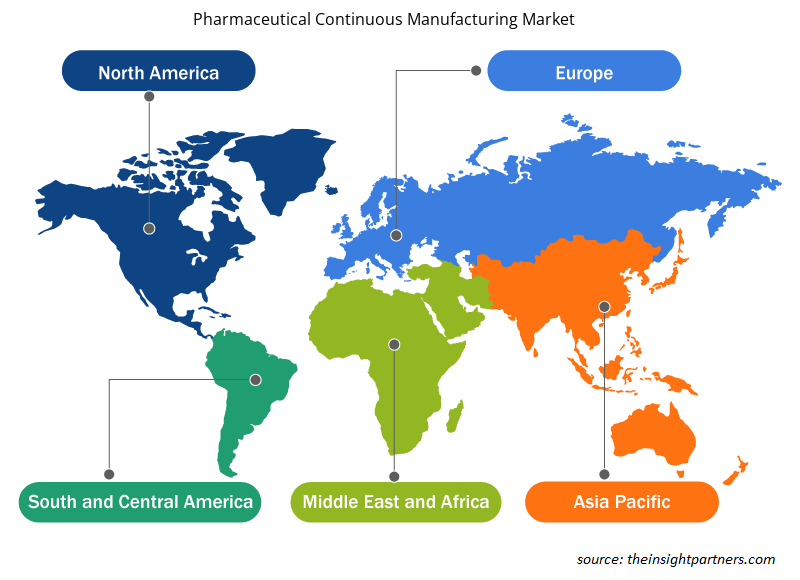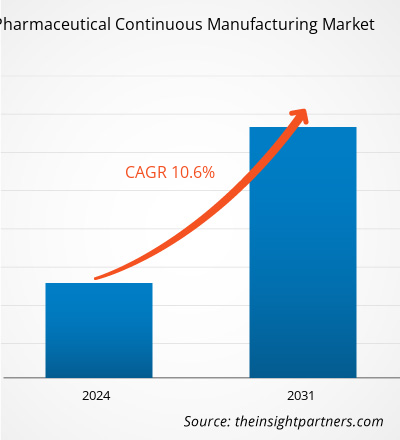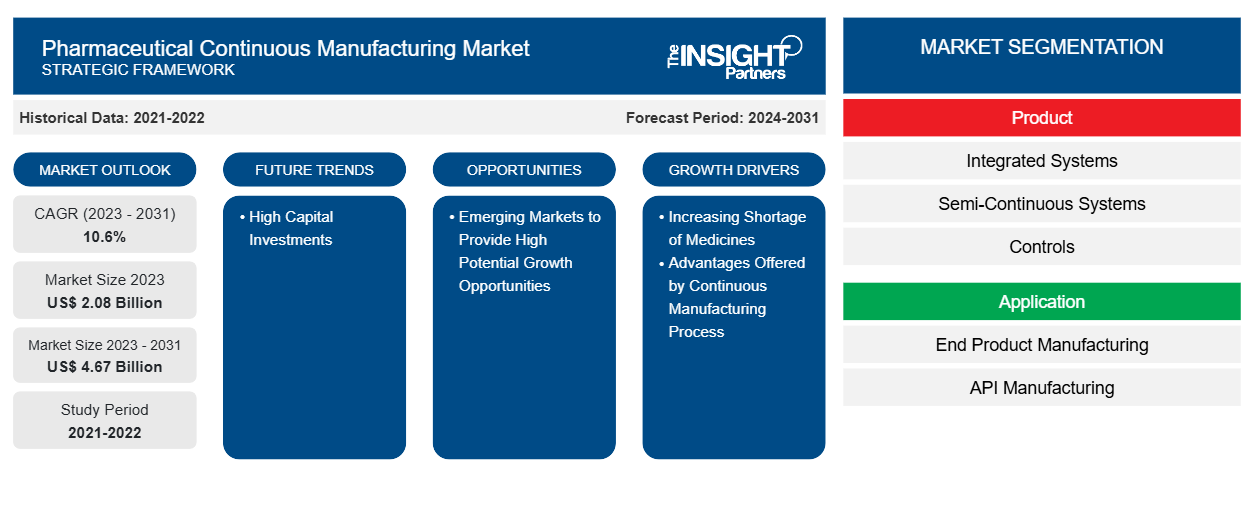من المتوقع أن يصل حجم سوق التصنيع المستمر للأدوية إلى 4.67 مليار دولار أمريكي بحلول عام 2031 من 2.08 مليار دولار أمريكي في عام 2023. ومن المتوقع أن يسجل السوق معدل نمو سنوي مركب بنسبة 10.6٪ خلال الفترة 2023-2031. ومن المرجح أن يظل الدعم المتزايد من الهيئات التنظيمية، والتبني المتزايد من قبل الشركات المصنعة للعقود والداخلية لإجراءات تصنيع الأدوية، والمزايا المرتبطة بالتصنيع المستمر، من الاتجاهات الرئيسية في السوق.
تحليل سوق التصنيع المستمر للأدوية
تستثمر شركات الأدوية باستمرار في تقنيات التصنيع المبتكرة للحصول على ميزة تنافسية والبقاء في المقدمة في السوق، وبالتالي دفع سوق التصنيع المستمر. يسمح التصنيع المستمر لشركات الأدوية بالتحكم بشكل أكبر في عملية الإنتاج الخاصة بها، مما يساعد في تحسين الجودة واتساق المنتج النهائي، وبالتالي تقليل الانحرافات والهدر وتوفير وقت إعادة العمل وتكاليف الاسترجاع. يمكن للتصنيع المستمر للأدوية تحسين جودة المنتج النهائي، وتعزيز التحكم في العملية، والسماح باختبار الإطلاق في الوقت الفعلي. تعد وكالة الأدوية الأوروبية (EMA) وإدارة الغذاء والدواء الأمريكية (FDA) الهيئات التنظيمية التي تفضل بشكل متزايد استخدام التصنيع المستمر في صناعة الأدوية. علاوة على ذلك، أصبح التصنيع المستمر أكثر جاذبية وعملية في صناعة الأدوية بسبب تحسين مراقبة العملية والتحكم فيها وتحسينها من خلال وسائل الأتمتة والتحكم في النظام وتحليل البيانات وتكنولوجيا تحليل العملية (PAT)، والتي تحرك السوق.
نظرة عامة على سوق التصنيع المستمر للأدوية
كحل قابل للتطبيق لتقليل الضغط وتقليل وقت تطوير الأدوية والتكاليف، مع الحفاظ على جودة المنتج النهائي والإمداد في صناعة الأدوية، يتم استخدام التصنيع المستمر على نطاق واسع. لذلك، نظرًا لهذه الفوائد، يشهد سوق التصنيع المستمر نموًا صحيًا. بالإضافة إلى ذلك، فإن المبادرات المتنامية لتعزيز استخدام أنظمة التصنيع الصيدلاني المستمر من قبل إدارة الغذاء والدواء (FDA) والمزايا العديدة لأنظمة التصنيع المستمر مقارنة بالتصنيع على دفعات هي بعض العوامل الرئيسية التي تدفع نمو السوق. ومع ذلك، من ناحية أخرى، من المرجح أن يعيق تنفيذ أنظمة التصنيع المستمر للأدوية ذات التكلفة العالية نمو السوق.
قم بتخصيص هذا التقرير ليناسب متطلباتك
ستحصل على تخصيص لأي تقرير - مجانًا - بما في ذلك أجزاء من هذا التقرير، أو تحليل على مستوى الدولة، وحزمة بيانات Excel، بالإضافة إلى الاستفادة من العروض والخصومات الرائعة للشركات الناشئة والجامعات
-
احصل على أهم اتجاهات السوق الرئيسية لهذا التقرير.ستتضمن هذه العينة المجانية تحليلاً للبيانات، بدءًا من اتجاهات السوق وحتى التقديرات والتوقعات.
محركات وفرص سوق التصنيع المستمر للأدوية
المزايا التي تقدمها عملية التصنيع المستمر لصالح السوق
يتم تبني التصنيع المستمر للأدوية واكتساب أهمية بسبب الطلب المتزايد على المواد البيولوجية وبدائل التصنيع المرنة. تحصل الشركات التي تنتقل إلى إجراءات التصنيع المستمر على الموافقات من إدارة الغذاء والدواء بسرعة. توفر عملية التصنيع المستمر العديد من المزايا التي تشمل كفاءة الوقت، وتقليل احتياجات الطاقة والهدر، وزيادة الإنتاجية. بالإضافة إلى ذلك، تقلل العملية من خطر الخطأ البشري بسبب مشاركة عدد قليل من الأشخاص في عملية التصنيع. لذلك، نظرًا للمزايا المذكورة أعلاه التي يوفرها التصنيع المستمر، فمن المتوقع أن ينمو السوق على مدى السنوات القادمة.
الأسواق الناشئة توفر فرص نمو ذات إمكانات عالية
تظهر مواقع الاستعانة بمصادر خارجية جذابة لصناعات الأدوية الحيوية في مناطق مثل آسيا والمحيط الهادئ وجنوب ووسط آسيا. توفر الصين والهند تكاليف تصنيع وتشغيل منخفضة وهي عوامل مهمة لدفع نمو السوق في منطقة آسيا والمحيط الهادئ. تشير كل من الصين والهند إلى توقعات مستقبلية إيجابية للسوق بسبب النمو الأخير في صناعة الأدوية الحيوية في كلا البلدين. في يناير 2020، افتتحت شركة STA Pharmaceutical Co.، Ltd.، وهي شركة تابعة لشركة WuXi AppTec منشأة تصنيع جديدة واسعة النطاق لمكونات الأدوية النشطة (API) من الأوليجونوكليوتيد في الصين. وبالتالي، من المرجح أن تعمل الأسواق الناشئة المناسبة لصناعة الأدوية الحيوية كمولدات نمو وإيرادات عالية الإمكانات في سوق التصنيع المستمر للأدوية.
تقرير تحليل تجزئة سوق التصنيع المستمر للأدوية
إن القطاعات الرئيسية التي ساهمت في اشتقاق تحليل سوق التصنيع المستمر للأدوية هي المنتج والتطبيق والمستخدم النهائي.
- بناءً على المنتج، يتم تقسيم سوق التصنيع المستمر للأدوية إلى أنظمة متكاملة وأنظمة شبه مستمرة وضوابط. احتل قطاع الأنظمة المتكاملة الحصة الأكبر في السوق في عام 2023 ومن المتوقع أن يسجل أعلى معدل نمو سنوي مركب خلال الفترة المتوقعة.
- من حيث التطبيق، ينقسم السوق إلى تصنيع المنتجات النهائية وتصنيع المواد الصيدلانية الفعالة . وينقسم قطاع تصنيع المنتجات النهائية إلى تصنيع الجرعات الصلبة وتصنيع الجرعات السائلة. احتل قطاع تصنيع المنتجات النهائية الحصة الأكبر من السوق في عام 2023. ومع ذلك، من المتوقع أن يسجل قطاع تصنيع المواد الصيدلانية الفعالة أعلى معدل نمو سنوي مركب خلال الفترة 2021-2031.
- بناءً على المستخدم النهائي، ينقسم سوق التصنيع المستمر للأدوية إلى شركات تصنيع كاملة النطاق وأقسام البحث والتطوير. احتل قطاع التصنيع الكامل أكبر حصة سوقية في عام 2023 ومن المتوقع أن يسجل أعلى معدل نمو سنوي مركب خلال الفترة المتوقعة.
تحليل حصة سوق التصنيع المستمر للأدوية حسب المنطقة الجغرافية
ينقسم النطاق الجغرافي لتقرير سوق التصنيع المستمر للأدوية بشكل أساسي إلى خمس مناطق: أمريكا الشمالية، ومنطقة آسيا والمحيط الهادئ، وأوروبا، والشرق الأوسط وأفريقيا، وأمريكا الجنوبية والوسطى.
لقد سيطرت أمريكا الشمالية على سوق التصنيع المستمر للأدوية. وترجع العوامل المؤدية إلى نمو سوق التصنيع المستمر للأدوية في أمريكا الشمالية إلى الدعم المتزايد من إدارة الغذاء والدواء الأمريكية لتعزيز استخدام التصنيع المستمر على التصنيع على دفعات، ونقص الأدوية المتزايد في المنطقة ووجود شركات الأدوية العملاقة التي يمكنها تحمل الاستثمارات الأولية الكبيرة لإنشاء عمليات التصنيع المستمر. تبنت غالبية الصناعات في الولايات المتحدة عمليات التصنيع المستمر منذ عقود. تحتل الولايات المتحدة مكانة مهيمنة داخل أمريكا الشمالية بسبب عوامل مثل العدد المتزايد من اللاعبين في مجال الأدوية الذين يتبنون إجراءات التصنيع المستمر، والتقدم في مجال تقنيات التصنيع والكفاءة التي توفرها هذه الإعدادات لزيادة أحجام الإنتاج. بالإضافة إلى ذلك، اتخذت إدارة الغذاء والدواء الأمريكية مبادرات مختلفة لتعزيز التصنيع المستمر في الولايات المتحدة داخل الصناعات الدوائية.
رؤى إقليمية حول سوق التصنيع المستمر للأدوية
لقد قام المحللون في Insight Partners بشرح الاتجاهات والعوامل الإقليمية المؤثرة على سوق التصنيع المستمر للأدوية طوال فترة التوقعات بشكل شامل. يناقش هذا القسم أيضًا قطاعات سوق التصنيع المستمر للأدوية والجغرافيا في جميع أنحاء أمريكا الشمالية وأوروبا ومنطقة آسيا والمحيط الهادئ والشرق الأوسط وأفريقيا وأمريكا الجنوبية والوسطى.

- احصل على البيانات الإقليمية المحددة لسوق التصنيع المستمر للأدوية
نطاق تقرير سوق التصنيع المستمر للأدوية
| سمة التقرير | تفاصيل |
|---|---|
| حجم السوق في عام 2023 | 2.08 مليار دولار أمريكي |
| حجم السوق بحلول عام 2031 | 4.67 مليار دولار أمريكي |
| معدل النمو السنوي المركب العالمي (2023 - 2031) | 10.6% |
| البيانات التاريخية | 2021-2022 |
| فترة التنبؤ | 2024-2031 |
| القطاعات المغطاة |
حسب المنتج
|
| المناطق والدول المغطاة |
أمريكا الشمالية
|
| قادة السوق وملفات تعريف الشركات الرئيسية |
|
كثافة اللاعبين في السوق: فهم تأثيرها على ديناميكيات الأعمال
يشهد سوق التصنيع المستمر للأدوية نموًا سريعًا، مدفوعًا بالطلب المتزايد من المستخدم النهائي بسبب عوامل مثل تفضيلات المستهلكين المتطورة والتقدم التكنولوجي والوعي المتزايد بفوائد المنتج. ومع ارتفاع الطلب، تعمل الشركات على توسيع عروضها والابتكار لتلبية احتياجات المستهلكين والاستفادة من الاتجاهات الناشئة، مما يؤدي إلى زيادة نمو السوق.
تشير كثافة اللاعبين في السوق إلى توزيع الشركات أو المؤسسات العاملة في سوق أو صناعة معينة. وهي تشير إلى عدد المنافسين (اللاعبين في السوق) الموجودين في مساحة سوق معينة نسبة إلى حجمها أو قيمتها السوقية الإجمالية.
الشركات الرئيسية العاملة في سوق التصنيع المستمر للأدوية هي:
- مجموعة جي إي أي
- شركة كوبيريون المحدودة
- شركة جيريك
- شركة جلات المحدودة
- مجموعة هوسوكاوا ميكرون
- شركة مونسون للآلات المحدودة
إخلاء المسؤولية : الشركات المذكورة أعلاه ليست مرتبة بأي ترتيب معين.

- احصل على نظرة عامة على أهم اللاعبين الرئيسيين في سوق التصنيع المستمر للأدوية
أخبار سوق التصنيع المستمر للأدوية والتطورات الأخيرة
يتم تقييم سوق التصنيع المستمر للأدوية من خلال جمع البيانات النوعية والكمية بعد البحث الأولي والثانوي، والتي تتضمن منشورات الشركات المهمة وبيانات الجمعيات وقواعد البيانات. فيما يلي بعض التطورات في سوق التصنيع المستمر للأدوية:
- بدأت شركة SK Bioscience، وهي منظمة تطوير وتصنيع عقود مقرها كوريا الجنوبية، العمل في توسعة تبلغ مساحتها حوالي 4200 متر مربع لمنشأة تصنيع لقاح L House في أندونج، جيونج سانجبوك دو، كوريا الجنوبية، والتي ستكون بمثابة قاعدة إنتاج لقاح المكورات الرئوية المقترن المرشح GBP410، والذي تم تطويره بشكل مشترك من قبل SK Bioscience وSanofi، اللتين تستثمران بشكل مشترك في التوسعة. (SK Bioscience، بيان صحفي، مارس 2024)
- أعلنت شركة Phlow Corp.، وهي شركة أمريكية تعمل في مجال الأدوية الأساسية، عن تحالفات استراتيجية مع معهد Medicines for All التابع لجامعة فيرجينيا كومنولث (VCU) وشركة AMPAC Fine Chemicals لتقديم خدمات البحث والتطوير المستمر في التصنيع لمنتجات الأدوية الجزيئية الصغيرة. بالإضافة إلى قدراتها الداخلية القوية والمتنامية، ستوفر شبكة Phlow من الشركاء الاستراتيجيين الراسخين والمبتكرين وذوي الخبرة حلول تصنيع متقدمة عالية الجودة ومقرها الولايات المتحدة لمكونات الأدوية الفعّالة الجزيئية الصغيرة (APIs) والمواد الأولية المسجلة (RSMs) في جميع مراحل التطوير باستخدام أحدث التقنيات ورؤى الصناعة الفريدة. (Phlow Corp.، News، مارس 2022)
تغطية تقرير سوق التصنيع المستمر للأدوية والمنتجات النهائية
يوفر تقرير "حجم سوق التصنيع المستمر للأدوية والتوقعات (2021-2031)" تحليلاً مفصلاً للسوق يغطي المجالات التالية:
- حجم سوق التصنيع المستمر للأدوية وتوقعاته على المستويات العالمية والإقليمية والوطنية لجميع قطاعات السوق الرئيسية التي يغطيها النطاق
- اتجاهات سوق التصنيع المستمر للأدوية بالإضافة إلى ديناميكيات السوق مثل المحركات والقيود والفرص الرئيسية
- تحليل مفصل لـ PEST و SWOT
- تحليل سوق التصنيع المستمر للأدوية يغطي اتجاهات السوق الرئيسية والإطار العالمي والإقليمي والجهات الفاعلة الرئيسية واللوائح والتطورات الأخيرة في السوق
- تحليل المشهد الصناعي والمنافسة الذي يغطي تركيز السوق، وتحليل خريطة الحرارة، واللاعبين البارزين، والتطورات الأخيرة لسوق التصنيع المستمر للأدوية
- ملفات تعريف الشركة التفصيلية
- التحليل التاريخي (سنتان)، سنة الأساس، التوقعات (7 سنوات) مع معدل النمو السنوي المركب
- تحليل PEST و SWOT
- حجم السوق والقيمة / الحجم - عالمي، إقليمي، بلد
- الصناعة والمنافسة
- مجموعة بيانات إكسل
التقارير الحديثة
شهادات العملاء
سبب الشراء
- اتخاذ قرارات مدروسة
- فهم ديناميكيات السوق
- تحليل المنافسة
- رؤى العملاء
- توقعات السوق
- تخفيف المخاطر
- التخطيط الاستراتيجي
- مبررات الاستثمار
- تحديد الأسواق الناشئة
- تحسين استراتيجيات التسويق
- تعزيز الكفاءة التشغيلية
- مواكبة التوجهات التنظيمية























 احصل على عينة مجانية ل - سوق التصنيع المستمر للأدوية
احصل على عينة مجانية ل - سوق التصنيع المستمر للأدوية